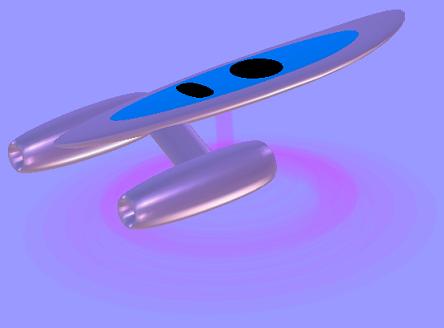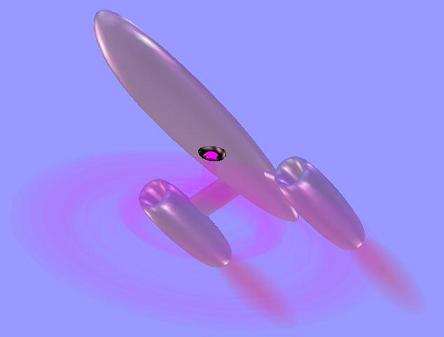Since the invention of gravitic field cancelling plasma, there has been quite a rush to make something really portable. Even ten years ago it would have been hard to get sufficient CPU power into a compact design, and so even if you could have done the gravity canceling, you wouldn’t have been able to keep the thing stable.
But now of course it’s a piece of cake. Pouring GFC plasma onto a counter-acting gravitational field actually generates power, and you can tap right into the current to power a forward thrust drive. Of course it’s all coming out of the Earth’s gravitational field, and I suppose that one day the rotation of our planet will slow down enough to be noticable. But I don’t think we need to worry about that quite yet!
Here are the first mock-ups, all to spec. The induced gravitic field just below the lift module is not as dangerous as it looks, although I still wouldn’t suggest spending all day in there:

The purplish hue in the plasma field is just an artifact of resonant photon absorption in the red/green part of the spectrum. You’ve probably read about U.V. blindness in people who spent too much time near those first prototypes. Not to worry, it isn’t really a problem anymore. The newer models are all properly U.V. shielded.
What I really like about this shot is how you can see the plasma spread out as it is literally pushed down against the Earth’s gravitational field, almost like it’s hitting a wall. The vehicle essentially rests on the induced force cushion. You need to use traditional means for forward thrust – in this case a simple magnetically accelarated ion air jet – because there’s no gravity difference between the front and the back of your hoverboard, so the GFC plasma is useless for lateral movement. If you used only the plasma, you could get up in the air, but you’d pretty much be stuck sitting in the same spot all day.
I like this shot, looking almost straight up at the vehicle, because you can see the striations in the plasma field. It turns out that the pulsing is necessary – the whole lift thing works only when the plasma gets into the right resonant frequency, almost like surfing waves of gravity from up off of the planet:

Riding one of these suckers is easier than it looks, since the computer feeds back your shifts in weight and makes small motions of the hoverboard to compensate. It’s pretty much impossible to throw yourself off – and I think that’s a good thing.
When you’re riding it properly, you’ll want to have your rear foot turned sideways, resting on the smaller of the little black pads. Your front foot should rest on the larger black pad, turned at more or less a 45o angle. You don’t use your hands at all to steer. The pressure imaging sensor in the top surface essentially captures a real-time video of the pressure from all parts of the bottoms of your feet, and uses that info to move the hoverboard.
Once you get the hang of it, it feels pretty much like an extension of your body. You kind of just think “lift” and it lifts, or “forward” and it starts to gain speed. Of course it’s not really reading your mind – just the ever-changing pressure image being formed by the bottoms of your feet.
After all, there’s no such thing as a vehicle that can read minds – that’s just science fiction.